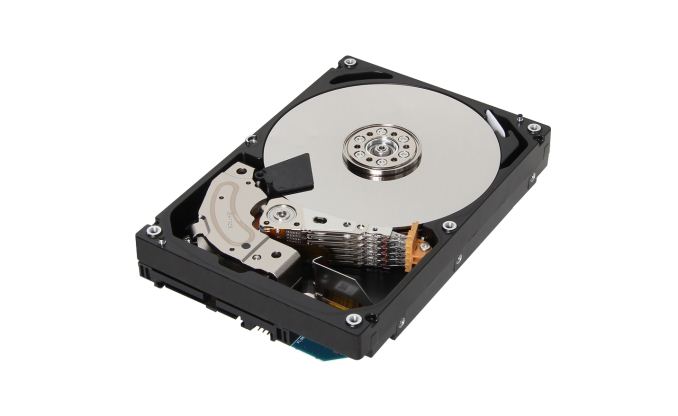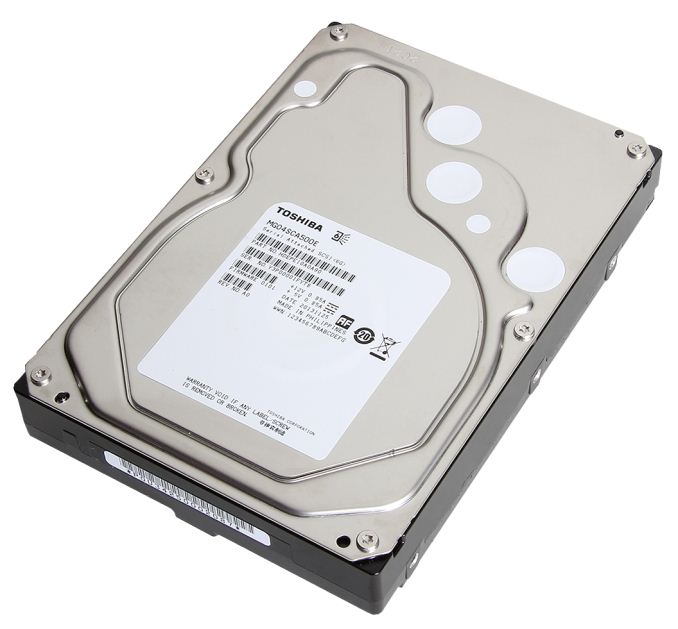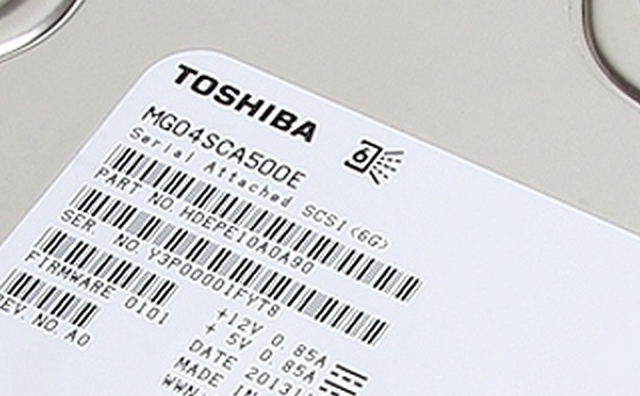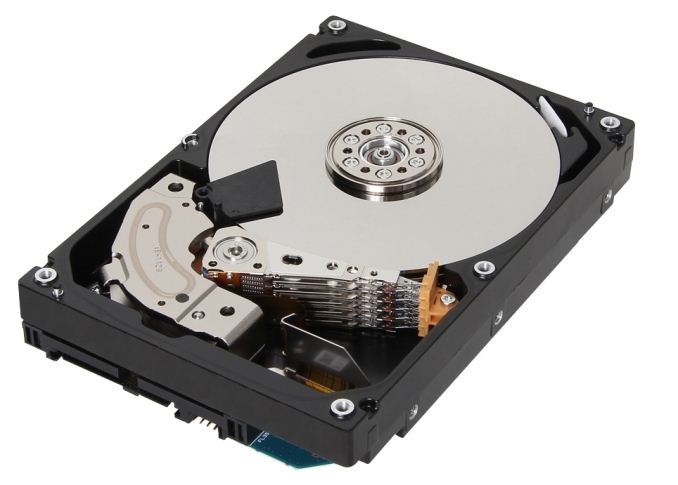5TB 3.5” Enterprise HDD from Toshiba Announced
by Ian Cutress on February 15, 2014 10:25 AM EST
Despite the focus on immediate storage is on the solid-state drive, whenever a large backup is needed then the mechanical hard-disk drive is still reigning supreme, and the demand for data density has never been higher. In the consumer space 4TB drives have been on sale for a while, currently for around $164 in the US or £123 in the UK. These were four platters at 1TB each, or five platters at 800 GB each, using PMR (perpendicular magnetic recording, remember this video?). Toshiba Electronics Europe has just announced the amalgamation of the higher platter density with the higher number of platters, in an enterprise level 5TB 3.5” 7200 RPM drive.
These new drives will fall under the MG04 heading, succeeding the MG03 range. Some of these drives also feature Persistent Write Cache Technology, which Toshiba states improves application performance and data-loss protection. The drives will be equipped with either 6Gb/s SAS (MG04SCA) or 6Gb/s SATA (MG04ACA) interfaces, and can also be supplied with Toshiba’s Sanitize Instant Erase (SIE) functionality.
The SIE drives have models that support either 512e or 4Kn format storage modes for modern performance or legacy applications. The drives are quoted with a 4.17ms average latency time, 8.5-9.5ms read/write seek time and a sustained transfer speed of 205 MiB/s. MTTF is at 1.2m hours, with idle power quoted as 6.2W, with 11.3W during read/write operations. The internal buffer for SATA drives is set at 128 MiB, with SAS drives having 64 MiB.
No information was given about release date and pricing – given the enterprise focus that Toshiba Electronics Europe is giving this product, I would imagine the focus would turn to local Toshiba representatives for individual pricing.
Given that one other company has been quoted as using Shingled Magnetic Recording in their 5TB drives for 2014, after speaking with Kristian we are under the assumption that this is still PMR technology. I must confess that at this point in the HDD cycle we might have 6TB 3.5” drives in the consumer market, but the recent focus on SSD consistency and a combination of overcoming physical limitations via new methods might be causes for the delay. HGST are sampling their 6TB helium filled drives, however that technology is aimed solely at the enterprise market. Should we get a sample in, keep your eyes peeled for a review.













42 Comments
View All Comments
name99 - Sunday, February 16, 2014 - link
OK, let's look at the graph.Seagate 4TB internal drive.
http://camelcamelcamel.com/Seagate-Desktop-3-5-Inc...
WD external 4TB drive:
http://camelcamelcamel.com/Drive-Security-Local-Ba...
Travelstar 1TB 2.5" drive.
http://camelcamelcamel.com/HGST-Travelstar-2-5-Inc...
They all follow the same pattern.
For a more aggregate view look at
http://www.extremetech.com/computing/153879-storag...
Or
http://www.zdnet.com/storage-in-2014-an-overview-7...
Everything shows the same pattern. Prices fell relentlessly. Floods in Thailand led to a bounce in prices. THEN around early 2013, we reverted to pattern, with prices again falling. The Backblaze price history of 4TB drives is particularly clear on this point because it's not confused by the Thai floods.
Dentons - Monday, February 17, 2014 - link
That you avoid using 2TB drives in your example is telling. Doing so would prove just how inaccurate your contention is. 2TB was perhaps the most common size, both then and now. 4TB drives were not available in 2011, or barely so.There has been price fixing in the hard drive market. There is no question of this. The only question is whether it has been tacit price fixing or active collusion.
It's difficult to understand why anyone would give Seagate and WD a pass on this, unless perhaps they work for one of those companies,
Fallen Kell - Monday, February 17, 2014 - link
I have to say you are picking and choosing to get those results. As Dentons pointed out, you did not look at drives that were on the market prior to the floods:http://camelcamelcamel.com/Western-Digital-Caviar-...
http://camelcamelcamel.com/HGST-Deskstar-3-5-Inch-...
Those show a pretty clear result that prices have been stagnant since the flood.
sonicmerlin - Tuesday, February 10, 2015 - link
Posting 1 year later, a look at those links shows prices have stayed exactly the same. If this isn't price fixing I don't know what is.sonicmerlin - Saturday, February 22, 2014 - link
Lol wow 1 TB and 4 TB. Did you really think no one would call you out?zodiacfml - Sunday, February 16, 2014 - link
less profit? i highly doubt it. they could have been making more money these days due to selling to enterprises and data centers. there is only less incentive for them to provide the consumer market with larger drives.fteoath64 - Sunday, February 16, 2014 - link
" they could have been making more money these days due to selling to enterprises and data centers". Too right. A captive market of repeating customers for sure. Look at the growth of data centres everywhere. They all rely primarily on HDD as their storage mediums. in fact, many are using consumer drives so they can replicate plenty of storage in order to handle data redundancy issue.I hope Toshiba keep making 2.5 inch drives of higher capacity and power saving ones for laptops. Also 1 inch drives of low power for future tablets. Due to the fixed lifespan of those drives, there is continued business so it can be sustainable for a top grade manufacturer serious about storage. The existing ones are just squeezing every cent from existing process without innovating much as SSDs takes over the low-capacity storage devices.
Gigaplex - Saturday, February 15, 2014 - link
Soon? We've had 1TB SSDs for quite a while now.name99 - Saturday, February 15, 2014 - link
"I must confess that at this point in the HDD cycle we might have 6TB 3.5” drives in the consumer market, but the recent focus on SSD consistency and a combination of overcoming physical limitations via new methods might be causes for the delay."I don't think this is a correct analysis. The companies (and individuals) working on better SSDs are not the HD companies.
I think a better explanation is that commoditization has destroyed the HD business. Competition has sent the price of drives so low that there is no profit left over to fund the R&D necessary to improve them. For a while IBM did the heavy R&D necessary (GMR, PRML, etc) to keep things going, but we've hit the limits of those techniques and no-one with deep pockets is around to do more than minor tweaks of existing tech that allow a reduction in price by a few cents.
This is basically the same process that killed the PC industry. (Intel kept up it's R&D, so CPUs kept improving; MS, for reasons unrelated to commoditization, screwed up its part of the R&D/improvement process; and the vendors, from Dell to HP to Lenovo, did nothing to improve their product over five years. Every "improvement" they did make was geared towards a cheaper device, not a better one.)
This is not COMPLETELY the vendors fault (PC or HD). Markets are not as perfect as your libertarian friends would have you believe, and one place they fail is precisely this sort of situation. In the absence of a benevolent more-or-less monopolist; once ATT, once IBM, currently (but maybe not for much longer) Intel, currently Apple and Google; competition to survive today means that fundamental R&D which benefits the entire industry does not get done.
The situation becomes unsustainable when commoditization is complete, when all I care about is buying a PC (not a Dell or an HP) or a drive (not a Seagate or a WD).
Apple has avoided it so far because people actually care that they get a Mac or an iPhone and are willing to pay substantially more for that.
Likewise Google so far delivers a superior enough product that people care that they are getting Google search not generic internet search.
Intel are headed for danger because there are few people who care that they actually have "Intel Inside", what they care about is "fast CPU, low power" inside and Intel is safe only as long as they deliver that more than the ARM competition...
But the HD vendors ARE to blame for the fact that every last one of them acted like a complete and utter retard in the face of SSDs. Rather than viewing their product as "persistent storage" and asking how they could use flash to improve that product, they insisted that what they were selling was "spinning metal" and that nothing could ever compete with that.
Even now, as they deliver too little too late, they insist on acting like idiots. For example WD sells, in the Black2, a product that is PERFECT for Macheads because it works so well with Apple's Fusion technology. And Macheads are the one segment of the market that are actually willing to spend money. How does WD exploit this opportunity? By conspicuously telling Apple fans "fsck you and all your lovely money, we're going to pretend it's still 1998 and sell a product that deliberately won't work well on your computers, even though all it would take to fix this is to provide a small app that automatically exposed our two drives and ran Core Storage Fusion on them."
So to summarize:
- drives suck because their no pot of money subsidizing their improvement
- this is 80% commoditization and 20% stupidity of the management at the drive companies.
purerice - Saturday, February 15, 2014 - link
Nobody can deny that you have done your research but your argument has a problem. For the longest time Apple insisted that "Mac" was not a "PC". PC vendors did try to differentiate themselves ("Dude, you're getting a Dell").HDD vendors to some extent do too, at least in my market. Yet flaming WD as an example for saying this Toshiba announcement is meaningless does not compute with me.
Then you attack libertarian thinking because you don't see more innovation in the HDD market. Really? 9 years ago I got a 250GB external drive for $200 that was wall-powered and weighed 1 pound. 4 years ago I got a 750GB external drive for $100, bus powered, weighing 0.6lb.
Last year I got a 1TB external drive for $90, bus powered, weighing 0.5lb.
This year for $90 you can get a 1.5TB external drive weighing 0.4lb.
So in 1 year there is a 50% increase in capacity and 20% reduction in weight at the same price point.
Does that not suggest the market is providing constant improvement in customer value?
Would not commoditization if it were happening, also mean improvement in customer value?